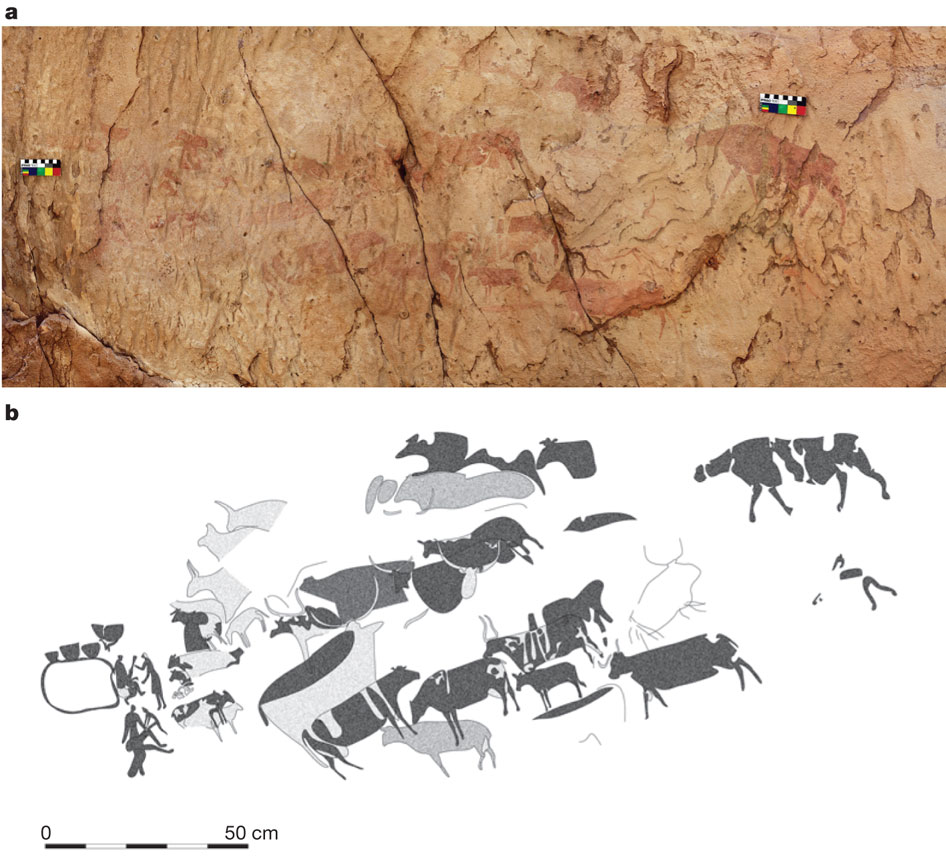<< Our Photo Pages >> Wadi Teshuinat - Rock Art in Libya
Submitted by coldrum on Monday, 02 July 2012 Page Views: 5261
Rock ArtSite Name: Wadi Teshuinat Alternative Name: Wadi Teshuinat, Tintararat, Tadrart Acacus, TashweenatCountry: Libya Type: Rock Art
Nearest Town: El Auis
Latitude: 24.851082N Longitude: 10.518035E
Condition:
| 5 | Perfect |
| 4 | Almost Perfect |
| 3 | Reasonable but with some damage |
| 2 | Ruined but still recognisable as an ancient site |
| 1 | Pretty much destroyed, possibly visible as crop marks |
| 0 | No data. |
| -1 | Completely destroyed |
| 5 | Superb |
| 4 | Good |
| 3 | Ordinary |
| 2 | Not Good |
| 1 | Awful |
| 0 | No data. |
| 5 | Can be driven to, probably with disabled access |
| 4 | Short walk on a footpath |
| 3 | Requiring a bit more of a walk |
| 2 | A long walk |
| 1 | In the middle of nowhere, a nightmare to find |
| 0 | No data. |
| 5 | co-ordinates taken by GPS or official recorded co-ordinates |
| 4 | co-ordinates scaled from a detailed map |
| 3 | co-ordinates scaled from a bad map |
| 2 | co-ordinates of the nearest village |
| 1 | co-ordinates of the nearest town |
| 0 | no data |
Internal Links:
External Links:
I have visited· I would like to visit
Andy B has visited here

According to the Italian-Libyan Archaeological Mission in the Acacus Mountains, some of the carvings found at Wadi Teshuinat belong to a period during which the region was inhabited by hunter-gatherers and which preceded the development of pastoralism; the depiction of two elephants on the same rock raised a great deal of interest because the two carvings belong to different periods; the left carving is the older one; its depth is reduced by erosion.
More, with images at romeartlover.tripod.com. View dozens more images of Rock Art at Wadi Teshuinat and the wider area at Libyan Soup's Flickr Pages.
Note: First evidence for early dairy farming in North Africa, 7000 years ago
You may be viewing yesterday's version of this page. To see the most up to date information please register for a free account.
Do not use the above information on other web sites or publications without permission of the contributor.
Nearby Images from Flickr






The above images may not be of the site on this page, but were taken nearby. They are loaded from Flickr so please click on them for image credits.
Click here to see more info for this site
Nearby sites
Click here to view sites on an interactive map of the areaKey: Red: member's photo, Blue: 3rd party photo, Yellow: other image, Green: no photo - please go there and take one, Grey: site destroyed
Download sites to:
KML (Google Earth)
GPX (GPS waypoints)
CSV (Garmin/Navman)
CSV (Excel)
To unlock full downloads you need to sign up as a Contributory Member. Otherwise downloads are limited to 50 sites.
Turn off the page maps and other distractions
Nearby sites listing. In the following links * = Image available
18.7km W 264° Tadrart Acacus Rock Art Rock Art
81.1km WSW 255° Sefar Rock Art Rock Art
84.5km WSW 257° Tassili* Rock Art
84.9km WSW 258° Tin Abateka Rock Art Rock Art
95.7km W 263° Tin Mgharen Rock Art Rock Art
105.4km W 270° Oued Amazak Rock Art Rock Art
110.2km ESE 113° Wadi I-n-Afuda Rock Art 2 Rock Art
112.2km ESE 120° Wadi Intananait Rock Art 2 Rock Art
114.5km E 85° Wadi Ti-n-Sharuma Rock Art 3 Rock Art
115.5km ENE 78° Wadi Taleschout Rock Art 3 Rock Art
116.7km ESE 104° Aramas-in-Kufar Rock Art Rock Art
117.3km ESE 108° Wadi Ankbritt Rock Art Rock Art
117.4km ESE 118° Wadi Intananait Rock Art 1 Rock Art
119.6km ENE 57° Wadi Imrawen Rock Art 3 Rock Art
119.7km ESE 109° Wadi I-n-Afuda Rock Art 1 Rock Art
121.7km E 84° Wadi Ti-n-Sharuma Rock Art 2 Rock Art
124.0km E 79° Wadi Taleschout Rock Art 2 Rock Art
129.1km E 82° Wadi I-n- Hagarin Rock Art Rock Art
130.2km ENE 59° Wadi Imrawen Rock Art 2 Rock Art
131.3km E 83° Wadi Ti-n-Sharuma Rock Art 1 Rock Art
133.4km E 79° Wadi Taleschout Rock Art 1 Rock Art
135.9km ENE 70° Wadi I-n-Aramas Rock Art Rock Art
136.1km NE 55° Wadi Meseknan Rock Art 4 Rock Art
136.9km ENE 61° Wadi Imrawen Rock Art 1 Rock Art
137.7km NE 53° Wadi Meseknan Rock Art 5 Rock Art
View more nearby sites and additional images






 We would like to know more about this location. Please feel free to add a brief description and any relevant information in your own language.
We would like to know more about this location. Please feel free to add a brief description and any relevant information in your own language. Wir möchten mehr über diese Stätte erfahren. Bitte zögern Sie nicht, eine kurze Beschreibung und relevante Informationen in Deutsch hinzuzufügen.
Wir möchten mehr über diese Stätte erfahren. Bitte zögern Sie nicht, eine kurze Beschreibung und relevante Informationen in Deutsch hinzuzufügen. Nous aimerions en savoir encore un peu sur les lieux. S'il vous plaît n'hesitez pas à ajouter une courte description et tous les renseignements pertinents dans votre propre langue.
Nous aimerions en savoir encore un peu sur les lieux. S'il vous plaît n'hesitez pas à ajouter une courte description et tous les renseignements pertinents dans votre propre langue. Quisieramos informarnos un poco más de las lugares. No dude en añadir una breve descripción y otros datos relevantes en su propio idioma.
Quisieramos informarnos un poco más de las lugares. No dude en añadir una breve descripción y otros datos relevantes en su propio idioma.